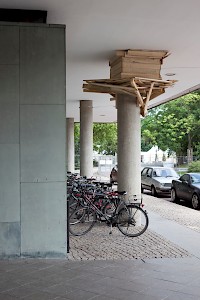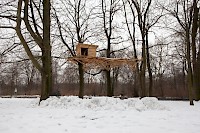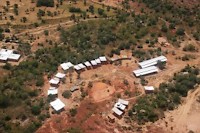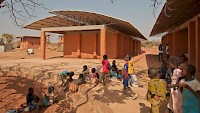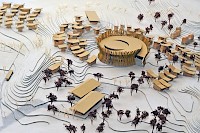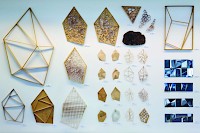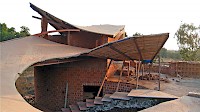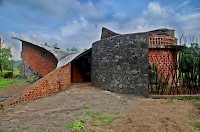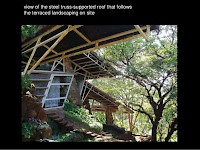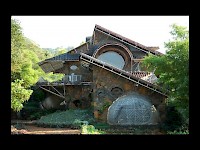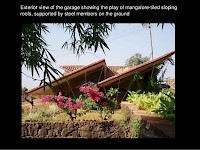Tradition and Architectural Representation
by Marta Jecu
Abstract
Very often tradition has been reinvented in order to legitimize a certain ideology, discourse or political agenda and representation has played a crucial role in this process. Any representation is itself the product of a row of representations, and moreover a tradition – a process through which content is transported and created. As for Cadava (Cadava 2001: 39) the image is never closed, content and form are often based on an invented genealogy.
In this article, I propose to focus on architecture and the way in which political content and ideology have been transmitted through the images architecture produces. These are intended to represent and apparently 're-produce' certain traditions. My examples will focus both on the discipline of architecture (specifically recent practices of recreation of vernacular architecture and construction techniques), and on artistic approaches of architecture.
'But what we call time is precisely the image's inability to coincide with itself.'
(Cadava 2011: 43)
'Everything passes in time but time itself!' proclaims on a quite melancholic tone Eduardo Cadava (Cadava 2001). For him, the present is not simply the present, but a result of the multitude of images that form it "now" and that might come from alien spaces and historical moments. Any image is for him always the image of another time.In his enchanting book Lapsus Imaginis: The Image in Ruins, Cadava (2001) practically explains the reason why an image can never be regarded as being complete and constituted. What Cadava calls the lapsus of the image (Lat. for lapse, slip, missing) reveals the inherent condition of the image which is to be perpetually undergoing the process of its constitution. For him the image exists through the dialectical relationship between a past and a present in a historical and imagistic sense. No image is for him simply itself. 'The image is always at the same time an image of ruin, an image about the ruin of the image, about the ruin of the image's capacity to show, to represent, to address and evoke the persons, events, things, truths, histories, lives and deaths to which it would refer. Nevertheless, what makes the image an image is its capacity to bear the traces of what it cannot show, to go on, in the face of this loss and ruin, to suggest and gesture toward its potential for speaking.' (Cadava 2001: 36).
The fact that the past can be experienced only in terms of loss and ruin, doesn’t mean that the constant need to produce it into the present is not recurrent. In fact, art and architecture are paradigmatic for the process in which the past is re-loaded into ‘the present image’ and therefore for the way in which 'traditions' are re-cast. These are not only formal visual traditions, but most of all ideological content that is transported and reinterpreted with every new invented representation.
Cadava talks about an image that is bearing several memories at once (2001: 39). He inspires a reading of the past that overpasses its reiteration and enactment. He advocates for internalizing and transforming the image of the past to suit the needs of the present. This thought recalls Eric Hobsbawm’s famous inaugural paragraphs in his Introduction to The Invention of Tradition (Hobsbawm, Ranger 1992), where he describes the way in which traditions imply an automatic continuity with a (for them) relevant past that is often fictitious. 'Traditions are responses to novel situations, which take the form of references to old situations' (Hobsbawm 1992: 2).
Very often tradition has been reinvented in order to legitimize a certain ideology, discourse or political agenda, and representation has played a crucial role in this process. In this article, I will explore how architectural representation is itself the product of a row, and moreover a tradition of representation – a process through which content is transported and created. Following Cadava’s notion that the image is never closed (2001: 39), I will draw on a few examples to show how content and form are often based on an invented genealogy.
In the following, I will focus on artistic and architectural cases in which political content and ideology have been transmitted through the images and the imaginary that architecture produces. These are intended to represent and apparently 're-produce' certain traditions. My examples will focus both on the discipline of architecture – specifically recent practices of recreation of vernacular construction techniques – and on technological experiments with environmental architecture.
I will also refer to artistic approaches of architecture, mainly based on case-studies recorded during my fieldwork at the 4th Marrakesh Biennale, which promoted an architectural approximation to local techniques through a decided conceptual approach. The cases I will discuss later in the article deal critically with architecture and aim to uncover political agendas that invoke what are in fact reinvented traditions in urbanism and habitation.
I will refer also to the so-called ecologic and 'vernacular' architecture offices, for example the Francis Kéré Architecture office in Berlin, Germany and the I-Studio India, in Mumbai, among others. I will consider as well critical examinations of 'traditional' techniques in experimental architecture coming from the field of conceptual art in the work of artists such as Sinta Werner and Tadashi Kawamata among others.
I would like to show the fact that the critical, anarchic and reactionary tradition of conceptual art, and its preoccupations with the discipline of architecture, have not only reflected back on the discipline, but have also revolutionised the understanding and theorizing of architecture. Artistic practices have shifted in the past decades the focus from architecture as habitation, to architecture as both philosophical experience and social practice. Deconstructivism and the postmodernism of the late 1980's advanced new ways of understanding architecture which destabilized architectural traditions and the values historically associated with architecture. These paths of thinking have been continued in the past decades in often non-representational, performative and conceptual works, which render the definition of 'tradition' rather complex.
DECONSTRUCTED ARCHITECTURE
In his writings and practical collaborations with the architect Bernard Tschumi, Jacques Derrida, proposed an architecture that surpasses the function of habitation. Derrida theorized in a body of texts and interviews1 (Derrida 1997, 1997b) an architecture which is transformative and essentially structured like an event – attributes that Derrida associated with the deconstructive ‘architectural experience.’ Derrida shifted at this point essentially the thinking on architecture, pleading for an architecture that is not necessarily subjected to the function of living and which steps out of Heidegger’s concept of ‘dwelling.’
For him architecture is a philosophical and conceptual experiment (Derrida 1989a) that materializes through a temporary event. Deconstruction, which is connected to the evenimential nature of architecture, is not a process meant to remove or destroy something that’s already been built (in a concrete or cultural sense) in order to make space for a domain that could be ‘cultivated’ again. On the contrary, deconstruction is essentially what he calls a ‘non-Heideggerian constructing and dwelling’ (Derrida 1989a: 74) – an architecture that does not find its finality in something outside itself (is non-architectural), but which also does not propose a nihilistic form of habitation.
Mainly, this new direction of thinking stepped out of the modernist attempt to restore a ‘pure’, ‘original’ architecture. Derrida also saw architecture as a result of the correlation with other media and other arts. Moreover, he also regarded the viewer (or user) of architecture as being a constituent part of architecture, as being inside the architectural body. The architecture ceases to be a container, and the user becomes a co-producer of the architectural event, which emerges only with the presence of its user. His concepts of trans-architecture and an-architecture (Derrida 1997b) were formulated to designate an architecture that exists only through the presence of an audience, as an essential condition of its existence: an-architecture is the place of what he calls the dynamic undermining of the tectonic and housing qualities of architecture whereas trans-architecture is a medium for making the user to meet the work, to invent it and to maintain it in the present (‘maintenant l’architecture’) (Derrida 1997b: 324–336, section 9).
Postmodern architectural experiments transposed quite literally the deconstructive theory of Jacques Derrida into practice – with the result of non-functional and quite absurd architectural environments, that found no utility or continuation in the discipline. Constructions like the private houses (House I–IV, House X) or the ‘Fin D’Ou T Hou S’ of Peter Eisenman manifest a disjunction in style: the fragment gains stylistic autonomy, the elements are opposed and juxtaposed into the body of the construction. These extreme 'deconstructed forms' were finally criticized for ending up negating what they were standing for and hindering use. More moderate constructions such as ‘Folie’ in Parc de la Villette in Paris (a practical as well as theoretical collaboration between Derrida and Tschumi) were integrated into the urban circuit, and the pavilions found easily uses such as restaurants, bars, cinemas, platforms, and viewpoints over the canal.
In the context of constant reinvention of architectural traditions of thought and practice, I would like to highlight what I believe to be the crucial role of contemporary art for the renovation and the critical examination of the discipline. I have argued that recent conceptual art practices related to architecture come close to Derrida's understanding of architecture (Jecu 2016) – closer than experiments made by the discipline itself. Approaching architecture in a performative, intellectual, non-formal way, recent artistic experiments with space and place reload the philosophical legacy of Derrida and at the same time transmit to the audience a more contextual and critical take on architecture, which is rather analytic than practical.
The critical uncovering of the complex mechanisms of the discipline and its 'traditions' through practices in experimental architecture and art contributes in its turn to its constant re-invention. These phenomena are particularly evident in recent discussions and experiments around the legacy of so-called 'environmental' or 'neo-vernacular' architecture. Contemporary art and experimental architecture have reloaded, but at the same time critically re-evaluated, the practically reinvented continuity of ecological traditions in urbanism and habitation. Just like Cadava's image, tradition remains open: it represents the moving sands resulting from plural and collective contestations and re-evaluations of legacies and their political implications.
By its nature, conceptual art is critically confronting not so much the creation of objects, but mostly the examination of social and political contexts of given objects or situations. Stepping out of the understanding of architecture in purely functional terms, recent conceptual practices are increasingly challenging the discipline by revealing complex economic and political agendas behind large-scale international programs of urbanism and habitation, involving the audience performatively in this re-evalutation of the discipline itself.
SUSTAINABILITY AND CONCEPTUAL HYBRIDS
In the following, I would like to present cases of artistic and low-scale, experimental architectural practices which deal with 'sustainable tradition' and which usually manifest a subtle questioning – embracing of vernacular techniques, while opening therefore new traditions inside the discipline. In these works, architecture is practised with the involvement of the audience in temporary, performative, interdisciplinary events that strongly recall the way in which Jacques Derrida envisioned the functions of architecture. Some of the works I will discuss further in the article become tools for contesting and renovating the discipline itself. Others can also become asphyxiated by an overflow of academic debate and establish a rather ambiguous and superficial relationship to the local context.
During my fieldwork at the 4th Marrakesh Biennale, I have conducted a series of interviews on architectural works which involved local crafts and established an approximation to the local historical context by integrating performance and collective participation in the body of the work.
Aleksandra Domanović's installation 'Monument to Revolution' (2012), produced by the Biennale, represents a commemorative construction that should bring to light historic links between the artists' context of origin (the former Yugoslavia) and the cultures of North Africa. The act of immersion and occupation of a foreign territory is often based on the creation of connecting links between the 'self' and the 'other.' Her monument was meant to celebrate the early adherence of both the former Yugoslavia and Morocco to the Non-Aligned Movement, as founding countries of the organization in the 1960s. For this purpose, Domanović creates a hybrid work, which applies local finishing crafts onto a typically 1960s modernist architectural profile. 'The work addresses both the exoticising of local craftsmanship and the domineering influence of modernism and its supposed universalism' – we can read on the artists' webpage at the Tanya Leighton Gallery2. Whereas the work aims to uncover this Western version of architectural modernism (which was adopted also in Morocco, in the 1950s Casablanca), the work nevertheless fails to avoid relying on other models than the same 'Western' clichés of representation – which it collages onto the Moroccan environment.I came to Marrakech for the first time in December. I was walking around and discovered that there are not many public monuments here, as we understand them. Another thing that I was inspired by was a technique of ancient Morocco, where limestone plaster is mixed with pigment. I had this 4,000 year-old Moroccan technique, used traditionally for hammams and palaces, in the bathroom of my hotel. It is called tadelakt in Berber and means literally to rub, as they rubbed it to squeeze out the air bubbles. It is a very cheap and ecological technique, but it is dying out. It started to get resurrected by the people who are buying and restoring riads in the medina. It has been imported in Europe as a extremely expensive and luxurious finishing. (Domanović 2012)
Another work produced for the Biennale was Elín Hansdóttir's Mud Brick Spiral, 2012,3 placed in a rural area near Marrakesh. Here the interest lies rather in working with the expressive qualities of the local materials. The artist constructs an installation that is destined for both the Western and local visitor, giving them the opportunity to experiment with the qualities and agency of brick and added mirror pieces by walking through a labyrinthine construction. I got very interested in the traditional Berber building technique, the mud bricks. I was fascinated by the fact that unlike us in the West, they almost use no tools during construction, it’s mainly manpower and imagination. Furthermore, it is interesting that they use the soil on the actual construction site to produce the building material. This results in whole villages almost seeming to mutate out of the landscape. (Hansdóttir 2012)
'Raw brick' will create for the 'Western' Biennale visitor an image of 'locality' and carries rural connotations. On the contrary, for the local kids and villagers which interact with the construction on daily basis, it will act as 'exotic' – a strange building typology made of a familiar material, which is not habitable and has no practical use.
In the following section, I would like to go deeper into the work of Tadashi Kawamata, an influential personality in the field of experimental and sustainable architecture. The architect-artist born in 1953, in Japan, is known for his temporary extensions of historic architecture, which he squeezes like nests on already built large-scale structures, starting with the 1980s. His working method became a reference with his 1989 Toronto installation, in which he connected two neo-classicist buildings on an abandoned lot of the Colonial Tavern Park with a huge heap of recuperated woodcuts engulfing the bank edifice.
Works-in-progress that are meant to disappear, most of Kawamata's performative installations are to be activated or transformed by the audience. For his Carton Workshop (2010) at Centre Pompidou4 he built a series of nests all over the façade of the centre. Previously that year he had built in Berlin another series of nests at Haus der Kulturen der Welt (Image 1, 2). These are commonly referred as 'social sculptures', 'nests of civil disobedience.' Characteristic of Kawamata’s practice are recycled and transformed materials. His temporary installations are all ephemeral and what remains are only sketches, leftovers of materials and traces. His Pompidou show featured nevertheless six cabinets, 'closets of memory,' which displayed a series of videos by Gilles Coudert documenting his projects over the last twenty years.
The Tree Huts remain out of reach and use. But their radical visual and poetic impact launches a doubt regarding the authority of institutions and representational program that are historically transmitted. At the same time his 'Nests' stimulate a physical and mental re-appropriation of the building which they parasitize. Kawamata compares his interventions to ‘natural phenomena’ in this way opposing two traditions. One tradition is that of an auratic architecture of display with its claims of durability – of which the iconic Centre Pompidou is an emblem. The other one is the 'tradition of the hut': found material in random shapes, improvised, ephemeral and precarious structures, subject to decay. These hybrid forms, which have no functions in the urban environment, can also be perceived as establishing a continuity with non-European building techniques (inscribing themselves in the philosophy of immateriality of the Japanese historic habitation). His work recalls also Japanese contemporary architecture (which Kawamata in fact anticipates with two decades). We can think for example of the iconic and radical buildings of Sou Fujimoto (House NA, 2008 or Wooden House in Kumamoto, 2006) or of another Japanese architect inspired by vernacular traditions, Shigeru Ban. Contrary to these examples of recent habitation architecture, Kawamata’s invasive and labyrinthine principles of construction show modes of detouring reality by introducing the factor chaos: polymorphous, hybrid elements based on motion, chance, transformation, dys-functionality.
This temporary manifestation of a potentiality for change represents a principle of creativity in relation to the authoritative context: the works bring out new functions in the given system. Using the codes of 'extra-European' traditions, they produce a result that surpasses what a system can actually generate, constituting an innovation in the given (actual) reality. At the same time these hybrids plead for the incorporation of marginal cultures, habitations and cultural practices in the mainstream European culture. Exposing an exclusive and dominant capitalist cultural system, Kawamata's art pieces have been nevertheless contested for indirectly contributing to the maintenance of the system they criticize. At one of the world's most luxurious art fairs, Art Basel, Kawamata constructed 'Favela Cafe' (2013)5, a rest place and bar built with techniques encountered in 'favelas.' The work introduces, on one hand, a neighborhood typology recognizable for its resourceful construction into the mainstream 'fair', but, on the other hand, it disregards the irony of quoting one of the most impoverished housing structures into the exclusive consumption site which is an art fair. In this sense it places itself on the border between raising awareness and mis-appropriation of the 'unprivileged foreign.'
It can be interesting to compare Tadashi Kawamata's conceptual practice with the works of an architectural office equally working with non-European building techniques. More linked to habitation, than to the critical examination of the discipline, I-Studio (www.istudioarchitecture.com/) intend to reintroduce vernacular building techniques into the high-class Indian living standards.
From an interview with one of the members of the office, Prashant Dupare,published in the online magazine Matter (Parikh 2017), we learn that the architects have drawn inspiration from both European building complexes in India and local crafts. Among his references, Dupare lists the modernist ensemble built by Le Corbusier in Chandigarh, India (designed 1953 and completed around 1968). 'What interests me from modernism is the idea of democratic wellbeing,' Dupare adds.For the work discussed in this interview, Brick House, 2013 (located in Wada village, Maharashtra Region),6 Dupare confesses that the starting point for the bungalow were the childhood memories of the client, who grew up in a small Indian brick village. In the same interview we read that brick was selected also for its 'flexibility in designing' and because of its texture, which 'lends itself to architecture in a way that allows one to feel close to nature. There is a sense of earthiness, tradition and age.'
The building technique and the philosophy behind are indebted – as Dupare reveals – to important architects in the history of Indian sustainable architecture, Laurie Baker and Nari Gandhi. Laurence Wilfred "Laurie" Baker (1917-2007) was a British-born Indian architect, renowned for his initiatives in cost-effective energy-efficient architecture. His designs that offered solutions for natural ventilation and light promoted the revival of regional building practices and use of local materials – inspired also by the personality and teachings of Mahatma Ghandi. He is historically acknowledged as a pioneer of sustainable and organic architecture which he associated with social and humanitarian goals, and for this he was called the "Gandhi of architecture".7 Nari Gandhi (1934–1993), another personality that inspired I-Studio, also worked for the reviving of ancient crafts, following his apprenticeship with Frank Lloyd Wright in the United States. Gandhi applied Wright's historic idea of 'organic architecture' to the Indian context and also involved local craftsmen for the completion of his works.
Brick House (2013) is defined by curved walls – each enclosing and opening to a space – and by the brick and stone used in multiple forms to create changing surface articulations. As the structure of the house is more complex than that of a rural habitation but the materials are the same, the stability of the building became a difficult point to solve. Nevertheless, as Dupare says in the quote above, the deciding aspect was the image that this type of architecture carries: 'earthiness, tradition and age.' Brick House follows the modernist – and at that time revolutionary – 'form follows function' Wrightian precept (Cruz, 2013), which Wright had himself adopted from Louis Sullivan. But I-Studio is nevertheless binding in also postmodern techniques extracted from the architecture of Auroville, namely the ferro-cement techniques. Built in the 1960s by the French architect Roger Anger, Auroville was another site of experimentation between Western and Asian techniques and principles, which seems to be more organic than Le Corbusier's Chandigarh.
Another architectural studio that I would like to discuss, also bridging Western and non-Western traditions and needs, is Francis Diébédo Kéré office.8 Born in 1965 in Gando, a small village in Burkina Faso, Francis Kéré not only re-implemented vernacular techniques in his projects in Ouagadogou, Burkina Faso, but also refused large scale projects in favour of what could be called 'workshop-architecture.' In his small scale projects, like the 2001 Gando Primary School,9 he developed techniques that could be easily copied by the local population for private use, also providing courses and training. His practice is a statement against large scale 'Western' programs involving local techniques for costly projects that end up being unfunctional for the local population or have no continuity.
In an interview with Kéré, Alain Juppe (Juppe 2012) asks him if the NGOs active in the region support his efforts to empower the local population when it comes to building.10
Francis Kéré: I am free and independent, I am not waiting for NGOs to offer me work in Burkina. I have openly said that big development infrastructures represent a business. Nevertheless, organizations such as GTZ in Germany create employment possibilities in Europe as well as in Africa – which is not negative. These gigantic structures devour a lot of money in order to function. If they would realize projects that would respond truly to the needs of the population, giving them the means to become self-governed, they would stop having a reason to exist.
Alain Juppe: Project is self-development and eco-building?
F.K.: I have never presented myself as politically engaged. Nevertheless I had the vocation to learn how to build with the purpose of improving the situation in my country.
A.J.: In order to best understand your work, could you please explain which is the situation of architecture and of the architects in Burkina Faso?
F.K.: In 2007, in Burkina we had no more than 50 architects. They were all working on large scale projects in big cities. In villages the people were doing their own building. What dominates is a lack of critical reflection in the profession, which actually reproduces a Western model. The situation looks similar from the point of view of the clients, who are capable of asking you to build them a copy of the White House. My approach is different. I have started with research on a small scale, asking myself: What can we achieve in quality and in durability by using the local materials and workforce? The bet is maybe won since the inhabitants of my native village are proud of the work we did in the community. I am not the first to have used earth in Burkina, there are big projects (like that of the Museum of Music in Ouagadougou led by the CRAterre institutional group) which use this building technique. But these are not models which are reproducible because these projects are huge, and everybody thinks that they should be done on this scale.
A.J.: This idea of adaptation of building techniques and materials, the idea of participation, are they transposable to the European context?
F.K.: The social approach is always possible but it has its limitations, even in Africa. If you don't want to loose money, you need to build fast, so it is impossible to wait until the community completes the training workshops. I think that in industrialized countries, in order to make this kind of transmission work, you need to re-evaluate the possibilities and adapt them to the industry machine. Determining the community to participate is a very difficult task, it is absorbing, but enriching.
These ambiguous questions are reinforced also in an extremely controversial project: the 'Operndorf Afrika' numele oficial e in germana set in Burkina Faso – an Opera House and the attached village, not finished to date. Francis Kéré and the visionary Christoph Schlingensief, both living in Berlin, started collaborating around 2008 for this project. Christoph Schlingensief, a German universal artist, was well known for his unconventional and interdisciplinary works in theatre, opera and film, political performance and activism. 'Operndorf Afrika'11 remained for a long time an utopia, mainly due to Schlingensief's premature death, but it is now being set into motion again. In 2008 Christoph Schlingensief asked Francis Kéré to find a physical form for a free stage on which his boundary-breaking intercultural opera could be staged. Questions arise regarding the legitimacy of a pre-eminent elitist European institution implanted in one of the economically most disadvantaged African countries. Schlingensief was known for having staged the most provocative and grotesque Wagner operas in Bayreuth, demolishing the previous conventions of the genre, and opera was for him a Gesamtkunstwerk in the tradition of Wagner, which went beyond the limits of the stage and extended unto an existential, universal dimension. Emerging out of this intellectual context, the Opera in Burkina Faso was meant to address the most sore points of colonization, in respect also to the German massacres in Cameroon. Schlingensief (2009) was constantly stressing the necessity to overcome the colonizing – colonized pitfalls of any European-African relationship through an essentially experimental approach. Only an artistic process or artistically understood quotidian interactions (between the local and invited participants), emerging from unpredictable collaborative actions without finality, can set new coordinates for previously corrupted relationships. In the same spirit Schlingensief (2008) calls his and similar actions in Africa 'official stealing' – and calls for an extreme assuming of the ambiguities of any action governed by this power relationship: 'The time has come to make stealing official!' he states in this 2008 interview. For him only art can fully incorporate and assume the dimension of these scars, which cannot be healed if they are not exposed and officially played out.
After a flood in Ouagadougou, in which most of the population lost their houses, Kéré an Schlingensief developed a habitation module, which could be easily reproduced by the locals and which would also integrate all the functions necessary for the running of the Opera. The project also included a music school, a hospital, a restaurant, ateliers and a community archive space, in which local population and international guests could develop their activities.
Schlingensief's approach is paradigmatic for other artistic attempts to contribute towards destabilizing the authoritative and hierarchical legitimacy of architectural projects implemented and financed by capitalist structures in non-European countries. Art has often functioned as a tool for uncovering mechanisms in which traditions in urbanism and habitation have been used to legitimize non-ethical urban planning and cultural political agendas.
In Schlingensief's discourse art is played out against the permanency, dominance, immutability of a persistent colonial tradition. Due to art's contextual approach, and its immediate and spontaneous response to social, cultural and political realities, Schlingensief regards art as the only possibility for any effective self-analytic and critical action-taking. His utopian project is meant to subsume the impermanence of an architecture of spectacle, which can escape its historic heritage through artistic liberation (theatre) and the physical body of an Opera House, which could be locally absorbed as it is integrated architecturally in its context.
Not only in his theatrical work, but maybe in this architectural approach too, Schlingensief follows a Wagnerian Romantic tradition in which art is understood as an universal cathartic experience.
In this and in similar projects that I will mention later in this article, art encompasses as such a virtual dimension, in the sense that it determines a becoming with an indefinite outcome. It represents a potentiality, which expresses the power to transform, to reaffirm and to regenerate both temporal and spatial coordinates. Such a dimension of becoming is generally inherent in the aspirations of non-local experiences like artistic incursions and interventions in a foreign environment. In the following section, I will discuss the phenomena of artistic and architectural residencies in 'foreign' cultures, which, on one hand, represent a tradition in themselves, on the other hand, are aiming to form a counter-culture in an ambiguous re-enactment of local heritage coupled with innovation. As conceptual art (the artistic approach that I am discussing in this article) is non-representational and non-permanent, the relation it establishes with patrimony is a complex one. By its nature, it refuses a literal or picturesque reproduction of clichés of heritage and defies permanency. In the last part of this article, I will focus on the works and thoughts of some conceptual artists regarding their recent takes on traditions and patrimony during residencies in what were for them foreign environments.
MOBILITY, IMMERSION, INTERVENTION
'IT IS NOT THE FACT THAT YOU ARE IN A FOREIGN COUNTRY THAT MAKES YOUR PRACTICE POLITICAL'
(Matsubara 2012)
The problem of immersion and intervention in a foreign context has often raised a biased vision: on one hand, the 'site' defined by sedentary qualities and, on the other hand, the guest artists, architect or cultural operator, who implement new structures, which are regarded as being mobile, interchangeable, liquid, and pertaining to a 'global flow.' I will take into consideration as a case-study the artistic residency at Dar Al-Ma’mûn, Morocco, which was meant to prepare the 4th Marrakesh Biennale curated by Naddim Samman and Carson Chan in 2012.12 With an architectural profile, this biennale – entirely financed by the British investor Vanessa Branson – integrated the residency as a sort of preparatory platform, where some of the artists involved could study the local customs, building techniques and get immersed into the rural context. Dar Al-Ma’mûn consists of a Swiss Foundation and a non-profit Moroccan law association based in Marrakech.
'Dar Al-Ma’mûn is a unique structure in Morocco and the non-profit-making status of our activities is a powerful force in unifying the Moroccan cultural interests and in raising its profile beyond borders,'13 is stated in the general concept of the residency.
As with any structure implemented into a foreign territory and financed from outside, a contrived conflict (between what is presented to be the static local community and the promoters connected to a global movement of goods and ideas) makes itself felt in this commentary. Indirectly this statement affirms a vision of locality and place as being a container of action and social processes which should be maximized by transporting them into the global context. Deterritorialisation of cultural acts is being advocated14.
In the context of the study of post-colonial transnationality and deterritorialisation in relation to foreignness and the self, and to building up knowledge of them, Homi Bhabha talks about the Third Space, which he calls the 'precondition for the articulation of cultural difference.' Babha reinforced the notion of cultural difference as a theoretical field in itself and opposed it to the shallow notion of 'diversity'. (Babha 2006: 155). The reason a cultural text or system of meaning cannot be sufficient unto itself is that the act of cultural enunciation—the place of utterance—is crossed by the difference of writing or écriture. This has less to do with what anthropologists might describe as varying attitudes to symbolic systems within different cultures than with the structure of symbolic representation—not the content of the symbol or its 'social function,' but the structure of symbolization. It is this 'difference' in language that is crucial to the production of meaning and ensures, at the same time, that meaning is never simply mimetic and transparent. (…)
The pact of interpretation is never simply an act of communication between the I and the You designated in the statement. The production of meaning requires that these two places be mobilized in the passage through a Third Space, which represents both the general conditions of language and the specific implication of the utterance in a performative and institutional strategy of which it cannot 'in itself' be conscious. What this unconscious relation introduces is an ambivalence in the act of interpretation. (...)
It is that Third Space, though unrepresentable in itself, which constitutes the discursive conditions of enunciation that ensure that the meaning and symbols of culture have no primordial unity or fixity; that even the same signs can be appropriated, translated, rehistoricized, and read anew. (Babha 2006: 156)
He also writes:It is the problem of how, in signifying the present, something comes to be repeated, relocated, and translated in the name of tradition, in the guise of a pastness that is not necessarily a faithful sign of historical memory but a strategy of representing authority in terms of the artifice of the archaic. (Babha 2006: 155)
Hybridity, deterritorialization and mobility are for Homi Babha producers of meaning. In recent tourism theory, mobility is seen as a form of dwelling, whereas moving is a modality of practicing space, of practicing culture through immersion in the experience of space (see, for example, Obrador Pons 2003). Place is not an individual experience, but a set of relationships, which become assembled in time, adapt to different circumstances and stay in continuous formation. Interventionist practices, residencies and site-specific projects are symptomatic for complex relations that connect movements of travel with what is often perceived to be the fixity of a perceived ‘here,’ enabling re-grounding and re-formulation of the delimitations of one's own place. Subjectivity and its formulation across a nomadic ‘home’-space is part of this cultural capital.15
Approaches, which have emphasized continuous contamination and movement, and not separation, have also been related to a sensory approach to geography,16 as a vision that is not exterior to its objects. The attitude goes back to the residencies and explorations of the artistic colonies of the Barbizonists in rural France or other landscape painters in Northern Africa (mostly Morocco and Tunisia) during the nineteenth century. Both then and now the artist-explorer is effectively and affectively delivered to a sort of cultural voyeurism in a world that requires a decidedly performative approach. As a consequence of this 'proximate approach' he also produces a social and economical network for the assimilation of his not immediately predictable and marketable work – the very result of his residency. This network extended from the place of origin to the adoptive place. It sustained the practical coordinates of movement and its resulting forms of knowledge production – processes that span from the nineteenth century to today.
In 1997, Kevin Hetherington (1997) described nomadic ‘home’ places in the contemporary world as ships, or mobile platforms, formed and sustained by the folding together of spaces and the relations of difference established by these folds. Place conceived as ‘circulating’ (Hetherington 1997: 187) connects cultural immersion with a haptic dimension of geographical exploration. Hetherington discusses construction of place and subjectivity through the role of touch, as a form of non-representationalist knowledge. Proximal knowledge is a form of unconditional acknowledgment of the immediate presence of the other, which therefore becomes part of oneself. (Hetherington 2003: 1932). In this article he explained that, through a proximal encounter with the praesentia of a place, which is experienced as both present and absent, the subject builds up a performative and non-representationalist knowledge.
This accent on the fluidity and universality of experience, which permits being at ease in a foreign environment and enjoying immersion in it, states an apparent non-hierarchical approach, but can be based also on a forced identification of the so-called 'other' with one's own value system and movements that equalizes in order to assimilate; for example, belonging/participation to universal activities in global capitalism or the goal of integrating the works (as final results of a directed process) into the global market. Part of this assimilation can be also an ethnographic interest for collecting elements of the 'local culture' (seen implicitly as 'real' or 'authentic') and introducing them into one's own art that is – since the Barbizonists' escapades into 'the rural' – a proof of integrating a certain context. Assimilating local craft techniques or elements within contemporary art practices may then pass as a 're-valorization', a 'saving' of traditional values by the contemporary artist, running the risk of affirming an implicitly domineering discourse or feeding a local nationalistic sensibility. This economically augmented 'saved tradition/idea/object' is then reintegrated into the global network. This is how Dar Al-Ma’mûn directors refer to the position, in the market system, of works produced during a residency: A residence is not a counterpoint to the market, but a time for the construction of work, and producer of works, that are possibly destined to arrive at institutions or other market participants. Although Dar Al-Ma’mûn has a non-profit status, a residency is finally a structure that rises as a market player to public recognition, and the recognition of the professional artists with whom it engages (Hamon 2012).
In the context of abstract conceptual artistic practices which imply performative knowledge of an unknown context of immersion, Kevin Hetherington's notion of non-representational forms of understanding and of proximate knowledge can be very helpful (2003). Hetherington's definition of the proximal knowledge best describes the meaning production in abstract art and conceptual object production: 'Proximal knowledge is (…) unsightly' and 'Proximal knowledge is not necessarily representational at all, rather it is performative, multiple, and heterogeneous in its outcomes' (Hetherington 2003: 1935). Conceptual, performative and non-representational forms of art are sustained by complex, global economic networks. Nevertheless their rapport to tradition is extremely complex and layered. In the context of non-representational knowledge production, the reproduction of naturalistic environmental practices reviving stereotyped traditions cannot find its place – as will be shown in the examples more down.
Hetherington's notion of performative knowledge shifts the focus away from the dichotomy Self-Other to more inclusive practices of mappings of a specific context (2003: 1934). Immersive knowledge is fluid, processual and uncertain. It is connected to thinking processes which are continuous and ‘unfinished’, whereas the object of enquiry is never attained (Hetherington 2003: 1935). Hetherington opposes this type of knowledge to the so-called 'distal knowledge.'
THE POLITICAL POTENTIALITY oF 'NOT-TO-DO'
Mobility encompasses a virtual dimension, in the sense that it determines a becoming with an indefinite outcome. It represents in itself a potentiality to modify both temporal and spatial coordinates. Following Giorgio Agamben (2008), the political relevance of this dimension of becoming, inherent in all non-local experiences consists not so much in the realization of given possibilities. Agamben invests with political potential not so much the accomplished dimension of achieved objectives, but the non-manifestation. For him the political engagement lies in the potential 'not to do.'
For Giorgio Agamben (1999, 2008), at stake in understanding the concept of potentiality is not the mere impotentiality, in the sense of impossibility, but rather the potentiality ‘not-to-do.’ This is not the absence of what could be done, but is that which proves that there exists the capacity to do something. The freedom to refrain from an act, proves that there exists a potentiality to act in a certain situation, which is in itself a positive/affirmative act. Agamben understands potentiality as something real, as a constituent part of reality. The potentiality 'not to' discussed in Agamben's volume Potentialities (1999) and especially in Chapter 11, ‘On Potentiality,’ is based on Aristotle, whom Agamben considers generally misinterpreted in regard to potentiality. Agamben is arguing that the essence of potentiality is not simply non-Being, but the presence of an absence. This potential not to pass into actuality is the one that interests Agamben. 'To be potential means: to be one's own lack, to be in relation to one’s own incapacity. Beings that exist in the mode of potentiality are capable of their own impotentiality, and only in this way do they become potential' (Agamben 1999: 182). The capacity, of one's own incapacity, is that in which freedom actually exists. Agamben calls the 'I can' '…for each of us perhaps the hardest and bitterest experience possible: the experience of potentiality' (1999: 178). This is because every human potentiality is in relation to its own privation. And he identifies this mechanism as 'the origin (and the abyss) of human power, which is so violent and limitless with respect to other living beings' (Agamben 1999: 182). From this perspective, it also becomes visible how 'the root of freedom is to be found in the abyss of potentiality' (Agamben 1999: 182).
An expression of the consciousness of the potentiality 'not-to-do' is often missing from discourses that equalize difference in order to legitimize intervention and the economic or cultural affirmation of authority. Relevant in this context is the fact that Agamben discusses the moment after a potentiality has passed into actuality and got realized. In the case of 'I can,' the sentence becomes ‘I did,’ whereas in the case of 'I cannot,' it becomes ‘I could have not’ (Agamben 1999: 187). Transposed into the context of an intervention of a subject into an environment foreign to him , this relation expresses the possibility of a politically correct act. The negation is accompanying the act, and the negation passes into the act, even when this is actualized: 'I could have not' accompanies the 'I did.' Only out of a relation to one's own incapacity ('I could have not') can the freedom of a voluntary act ('I did') be fulfilled as a potential of which the subject is aware.
DIGITAL DUNES
There has been an increasing interest amongst architectural historians in addressing the role of design and technology for the historical relationship between the built and the natural environment across the twentieth century. This has also involved correlating the shifting discourse on environment with a history of architectural transformations and disciplinary expansions. Techno-cultural developments not only produced novel designs, they also placed architecture as a mediator, facilitating novel conceptions of the relationship between social and biotic systems. Art has played an important role in the establishment and theoretical development of an environmental history of architecture. It has reloaded and reconsidered changing cultural approaches to the environment across the long twentieth and the beginning of the twenty-first centuries and permitted experimentation for larger scale projects.
Recently the idea of post-humanism became relevant for defining artistic and cultural practices, in which the nature of an object is defined not by its form, but by its content in information. As nature and technology are progressively fusing, the form of embodiment in a certain biological substrate becomes less defining. We are obliged to consider the constantly transformative character of most of the objects surrounding us, interchangeable structures, prosthesis, adjustments, temporary forms, that are completing and incessantly modifying the human body and nature itself. In the so called post-human era, as in the post-human technologies and implementation projects, there are no essential differences between bodily existence and computer stimulation, between virtual and material, between organic thinking and cybernetics.
Barkow Leibinger Architects17 based in Berlin belong to what could be called an 'organic digital trend,' and they can be seen as promoting a post-humanism in which nature and the environment of the human being suffer various enhancements. In their sophisticated designs they reproduce organic and vernacular structures, materials and patterns using high-tech means. They produce architectural structures and surfaces by inventing new materials and also the tools to produce them. Laser technology is invested in order to recreate organic membranes originating in ancient product design from varied cultures. Their credo is a reverse of the famous 'Form Follows Function', first formulated by Frank Lloyd Wright - into 'Form follows Material'. The possibilities of newly invented materials dictate the emergence of architectural form, which is set to respond to the sensory necessity of their user.
With 'Atlas of Fabrication' (2009), an exhibition that was developed for the Architectural Association in London, the architects map out their particular world-view. They expose mainly their architectural imagination which builds on a deep fascination with materials extracted from various traditions and cultures and their uncharted potentials – expanded with the use of digital techniques.
Their public space installation Loom Hyberbolic (2012) uses Moroccan traditional cotton binding techniques, and, although it is the result of complex digital algorithms, it embodies at the same time a definite attempt at site-specificity, in the sense of integrating the pieces into the surrounding landscape, involving local labor and their solutions. For this work, in which they used software like Grasshopper and Rhino, their starting point was a research on geometrical algorithms in vernacular Moroccan architecture, which they replaced with digital algorithms – therefore turning technology itself into a material of their architecture.
'The most compelling shifts in design occur when technologies and fabrication capabilities are made available and interpreted in new ways,' they affirm (Chan 2009).18
Barkow Leibinger Architects are at the forefront of a generational shift in architectural experimentation based upon sustainable forms, material research, digital fabrication, and a conceptual, experimental vision on space and architecture.
Also based on a digital approach, the work of Sinta Werner 'The Problem of Translation' (2012)19 is concerned with landscape forms encountered in Morocco, which she intends to turn into architectural forms, based on digital software. Her metaphysical search for a fixed form among the always transforming natural shapes is a search for the laws of time and movement, which she intends to incorporate into the dimension of architecture. Her work is concentrated on the shape of sand dunes. Movement, that makes a dune exist, becomes for her a principle of building a model of architectural structure which can only be created with computer programs.
In the following interview excerpt, she gives a deeper understanding of her focus and process:
Sinta Werner: The idea came from making a generic form: a dune set that comes from the nature encountered in Morocco but that is a perfect form, made by coordinating the winds and the dunes. The dunes I animated in a program called Cinema 4D, and I transformed it back into something physical, which I built with rudimentary, basic tools and materials.
Marta Jecu: You animated the dunes, brought them into movement and then brought them back into a still? In this sense, you fused natural landscape with a digital imagination and with local, analogue materials and building crafts in Morocco?
S. W.: Yes, these connections are marked by my use of colour. I wanted the colour to look quite synthetic, like a non-colour. This yellow neon that I use to coat the installation is something that is used for street signs. It is something very aggressive and artificial. I wanted to put a contrast to the natural forms that inspired me.
CONCLUSION
I have tried to explore in this article how architectural representation is the product of an often contradictory and politically ambiguous tradition of representation – which carries superposed images and content. I have tried to show, using various examples, how the appeal to a tradition or to the vernacular is often based on a forced identification of the so-called 'other' with one's own value system and movements that equalizes in order to assimilate. In cases such as artworks and temporary architectures produced during the Marrakesh Biennale, for example, we witness, on one hand an, ethnographic interest for collecting elements of the 'local culture' (seen implicitly as 'real' or 'authentic') and introducing them into one's own art that is a proof of integrating a certain context. On the other hand, assimilating local craft techniques or elements within contemporary art practices may then pass as a 're-valorization,' a 'saving' of traditional values by the contemporary artist, running the risk of affirming an implicitly domineering discourse or feeding a local nationalistic sensibility. In dialogues like those with Francis Kéré and Megumi Matsubara we have seen how 'interventions' in foreign contexts and participatory social actions ultimately contribute less to an economic balance, but rather participate in universal activities of global capitalism and the global market.
Following Francis Kéré, we can see how big development infrastructures are conceived to realize projects that cannot truly respond to the needs of the population, enabling them to become self-governed, otherwise project developers would stop having a reason to exist. Nevertheless the images transmitted through the buildings these structures produce are meant to feed the imaginary about vernacular traditions – for the European eye as well as for the local population.
In this article I consider also the critical, anarchic and reactionary potential of conceptual art for this context. Artistic practices have shifted in the past decades the focus from architecture as habitation to architecture as both philosophical experience and social practice, until recent practices in the so-called post-humanism - which render the definition of 'tradition' rather complex.
These are nevertheless not less controversial - for example Christoph Schlingensief's Operndorf Afrika, which is paradigmatic for other artistic attempts to contribute towards destabilizing the authoritative and hierarchical legitimacy of architectural projects implemented and financed by capitalist structures in non-European countries. He regards art as the only possibility for an effective self-analytic and critical action-taking, which acts on a micro-level – the only possible level of an anarchic counter-action. Schlingensief considers art as a cathartic tool for uncovering political mechanisms which legitimize non-ethical urban planning and cultural political agendas. In Schlingensief's discourse art is played out against the permanency, dominance, immutability of a persistent colonial tradition. His project stays nevertheless utopian and has not been finalised after his death.
I would like to end this incursion through various traditions of thought in experimental architecture with a quote from Jacques Derrida:
The architecture of the ‘tradition’ belongs to the space of the mimesis. It is traditional; it constitutes the tradition by itself. Despite appearances the ‘presence’ of an edifice does not refer only to itself. It also repeats, signifies, evokes, convokes, reproduces and cites. It carries towards the other and refers to itself, it divides even in reference. [...]
(Derrida 1989b: 67, Aphorism 13)
REFERENCES
Agamben, Giorgio. 2008. Über negative Potentialität. In Nicht(s) sagen. Strategien der Sprachabwendung im 20. Jahrhundert. Emmanuel Alloa, Alice Lagaay (eds.). Transcript Verlag: Bielefeld, 285-298.
Agamben, Giorgio. 1999. Potentialities, Collected Essays in Philosophy. Stanford University Press: Stanford California.
Bhabha, Homi. 2006. “Cultural Diversity and Cultural Differences.” In The Post-Colonial Studies Reader. Ashcroft B., Griffiths G., Tiffin H. (eds.).Routledge: New York, 155–157.
Bruno, Giordana. 2002. The Atlas of Emotion: Journeys in Art, Architecture, and Film. New York: Verso.
Cadava, E. 2001. Lapsus Imaginis: The Image in Ruins. October 96 (Spring): 35-60.
Chan, Carson. 2009. Atlas of Fabrication. 032 Magazine/2009. Retrieved April 19 2017 (https://032c.com/2009/atlas-of-fabrication/).
Cruz, Cesar A. 2013. “Wright’s Organic Architecture: From ›Form Follows Function‹ to ›Form and Function are One‹.” Cloud Cuckoo Journal, no. 1996. Retrieved April 16, 2017 (http://www.cloud-cuckoo.net/journal1996-2013/inhalt/de/heft/ausgaben/112/Beitraege/2.2%20%20%20Cruz.pdf).
Derrida, Jacques. 1989b. ”Fifty-two aphorisms for a foreword.” In Deconstruction. A. Papadakis, C. Cooke, A. Benjamin (eds.). New York: Rizzoli International Publications, 67–72.
Derrida, Jacques. 1991. Mémoires d’aveugle, L’autoportrait et autres ruines. Paris: Réunion des Musées Nationaux.
Derrida, Jacques. 1992. Die Wahrheit in der Malerei. Vienna: Passagen Verlag.
Derrida, Jacques. 1997a. ”Why Peter Eisenman writes such good books.” In Rethinking Architecture. A Reader on Cultural Theory. N. Leach (ed.). London, New York: Routledge, 336–347.
Derrida, Jacques. 1997b. ”Point de Folie – Maintenant l’ Architecture” – Section 3. In Rethinking Architecture. A Reader on Cultural Theory. N. Leach (ed.). London, New York: Routledge, 324–336.
Derrida, J., and E. Meyer1997. ‘Architecture where the desire may leave – A dialogue.’ In Rethinking Architecture. A Reader on Cultural Theory. .N. Leach (ed.). London, New York: Routledge, 319–323.
Derrida, J. and C. Norrisin Discussion. 1989a. In Deconstruction. A. Papadakis, C. Cooke, A. Benjamin (eds.). New York: Rizzoli International Publications, 71–75.
Domanović, Alexandra, and Marta Jecu. 2012. Interview. Unpublished.
Hamon, Carleen, and Marta Jecu. 2012. Email Interview. Unpublished.
Hansdóttir, Elín, and Marta Jecu. 2012. Interview. Unpublished.
Hetherington, Kevin. 1997. “Place of Geometry: The Maturity of Place.” In Ideas of Difference. Kevin Hetherington and R. Munro (eds.).Oxford: Blackwell.
Hetherington, Kevin. 2003. Spatial textures: place, touch, and praesentia. Environment and Planning A, 35 (11): 1933–1944.
Hobsbawm, E., and T.Ranger(eds.). 1992. The Invention of Tradition. Cambridge: Cambridge University Press.
Jecu, Marta. 2016. Architecture and the Virtual, Chicago: University of Chicago Press.
Juppe, Alain. 2013. Interview with Francis Kéré. Exhibition Catalogue “Diébédo Francis Kéré Bridging the Gap.” Bordeaux: Centre d'Architecture Bordeaux, 1-12.
Matsubara, Megumi and, Marta Jecu. 2012. Interview. Unpublished.
Obrador Pons, Pau. 2003. “Being-on-holiday, Tourist dwelling, bodies and place.” Tourist Studies. 3(1): 47–66.
Parikh, Ruturaj. 2017. “A conversation between Prashant Dupare of iSTUDIO architecture and Ruturaj Parikh of Matter: on The Brick House.“ Archiving Thought. Retrieved April 16, 2017 (https://thinkmatter.in/2015/01/13/brick-house-istudio-architecture/).
Schlingensief, Christoph. 2009. So schön wie hier kanns im Himmel gar nicht sein!: Tagebuch einer Krebserkrankung. Koeln: Kiepenheuer&Witsch.
Schlingensief, Christoph. 2008. Interview with TAZ Magazine. November 12. Retrieved on April 16, 2017 (http://www.taz.de/!5172864/).
www.lauriebaker.net/ Retrieved April 16, 2017.
1 See complete bibliography under Derrida, J.
2 See http://www.tanyaleighton.com/index.php?pageId=498&l=en
3 See https://www.designboom.com/art/mud-brick-and-mirror-spiral-installation-by-elin-hansdottir/
4 For details, see http://artistes-k-l.artcatalyse.com/tadashi-kawamata-carton-workshop-et-huts-au-centre-pompidou.html
5 See https://www.designboom.com/architecture/favela-cafe-by-tadashi-kawamata-occupies-art-basel/
6 For details, see http://www.archdaily.com/599780/brick-house-istudio-architecture
7 For more information, consult his website: www.lauriebaker.net/
8 For Kere's projects please consult his website: http://www.kere-architecture.com/projects/secondary-school-dano/
9 For Kéré’s complete projects see his website : http://www.kere-architecture.com/projects/primary-school-gando/
10 My translation of excerpts from the French original interview.
11 For details, see http://www.operndorf-afrika.com/fr/focus/architecture/
12http://www.marrakechbiennale.org/previous-editions/4th-edition
13 My italics. General statement of the Dar Al-Ma’mûn residency's goals, see under: http://dam-arts.org/#/en/1
14 The term Deterritorialisation was introduced by Gilles Deleuze and Félix Guattari in Anti-Oedipus (1972) and refers to the current global context in which human subjectivity becomes destabilised , fluid, shifting and ungrounded. The term equally refers to spatial coordinates with their political and institutional implications in the contemporary capitalist societies.
15 The concept of a nomadic subject and of nomadism as a defining condition of contemporaneity was established by Gilles Deleuze and Felix Guattari in Mille Plateaux (Paris, Éditions de Minuit, 1980).
16 For example, works that connect psychogeography with film and the arts, see Bruno 2002.
17 See www.barkowleibinger.com/
18 Carson Chan citing Barkow Leibinger.
19 See http://www.higheratlas.org/sinta-werner/
